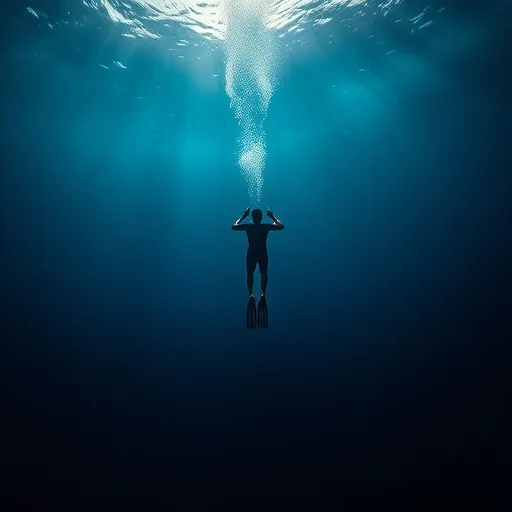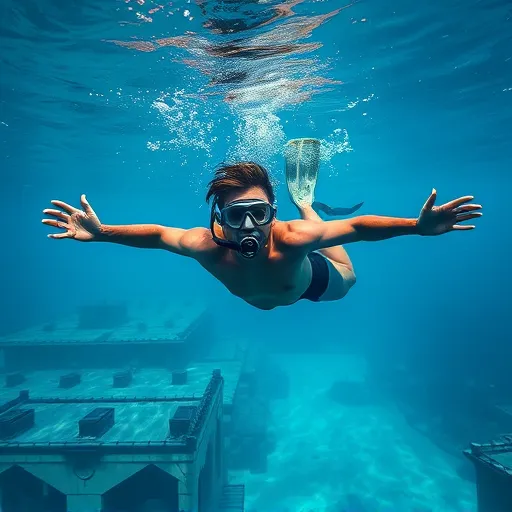The Incredible Free Diving World Records
Dive into the astonishing world of free diving records and the athletes who push the boundaries of human potential.
Free diving isn't just a sport; it's an amazing mix of human endurance and a close bond with the underwater world. Let's look at the most astonishing free diving world records, meet the athletes behind them, and see how they push beyond normal limits.

How Free Diving Records Have Changed Over Time
Free diving has come a long way since it began. Curiosity and competition have driven people to dive deeper and stay underwater longer. Let's see how these records have changed over the years.
Early Free Diving for Survival
Long before it was a sport, ancient people held their breath to dive underwater for survival. Pearl divers in Japan and oyster collectors in the Mediterranean depended on diving deep without gear. They set the stage for what would become a sport known around the world.
First Big Achievements in Free Diving
In 1913, Greek sponge diver Stathis Chantzis made the first recorded free dive to 66 meters (217 feet). This amazing feat opened the door for others to dive even deeper. In the 1940s and 1950s, pioneers like Raimondo Bucher and Enzo Maiorca set new records, bringing attention to the sport.
Free Diving Becomes a Competitive Sport
In the 1980s and 1990s, free diving became an official competitive sport. Groups like AIDA International were formed to promote safe practices and hold competitions. Athletes started focusing on different disciplines, like Constant Weight and No Limits, each with its own challenges.
Record-Breaking Divers Who Made History
Some athletes have made history by setting unbelievable free diving records.

Alexey Molchanov
Alexey Molchanov is a Russian diver well-known for holding multiple world records. In July 2023, he dove to an incredible depth of 130 meters (426.5 feet) using a monofin in the Constant Weight category. His dedication and new training methods inspire many divers. Molchanov also developed the Molchanov Technique, a training system used worldwide.
Herbert Nitsch
Herbert Nitsch, called "The Deepest Man on Earth," set a No Limits world record by diving to 214 meters (702 feet) in 2007. In this discipline, divers can use weighted sleds to go down and inflatable bags to come up. Though he faced severe decompression sickness after trying to dive deeper, his achievements are still a benchmark in free diving. Nitsch's records show the extremes humans can reach and the risks involved in pushing those limits.
William Trubridge
William Trubridge from New Zealand has greatly contributed to the sport, especially in the Free Immersion category, where divers go up and down by pulling on a rope without fins. In 2016, Trubridge set a world record by diving to 124 meters (406.8 feet) in this discipline. His focus on pure technique and simplicity captures the essence of free diving.
Women Who Pioneered Free Diving
Women have also made big strides in free diving.
Alessia Zecchini
Alessia Zecchini from Italy holds multiple records, including a Constant Weight dive of 113 meters (371 feet) in 2019. Her passion and commitment show that diving deep has no gender boundaries. Zecchini is a role model for female athletes around the world, proving that determination and hard work can break barriers.
Natalia Molchanova
The late Natalia Molchanova, mother of Alexey Molchanov, was one of the most decorated free divers ever. She held 41 world records and won 23 world championship titles. Molchanova's contributions went beyond competition; she developed training programs and advanced free diving techniques. Her legacy still influences the sport today.
Understanding Different Types of Free Diving
Free diving includes various disciplines, each testing different skills.

Constant Weight (CWT)
In this type, divers go down and come up using their fins or a monofin, without changing their weight. It tests strength, technique, and efficiency.
Free Immersion (FIM)
Divers pull themselves along a rope without fins. This emphasizes upper body strength and breath control.
Static Apnea (STA)
Athletes hold their breath while floating face down in the water, focusing on relaxation and mental control. This tests pure breath-holding ability.
No Limits (NLT)
Divers use a weighted sled to go down and an inflatable device to come up. This allows for the deepest dives but is the most risky.
The Science of Holding Your Breath
Holding your breath for a long time isn't just about willpower; it's rooted in how our bodies work.
The Mammalian Dive Reflex
When we go underwater, our bodies trigger the mammalian dive reflex, a survival mechanism we share with dolphins and seals. This reflex includes:
Bradycardia: Slowing of the heart rate to save oxygen.
Peripheral Vasoconstriction: Narrowing of blood vessels in the limbs to send oxygen to vital organs.
Blood Shift: Blood plasma moves into the lungs to protect them from pressure at depth.
Training Adaptations
Free divers train to enhance these natural responses. Over time, their bodies adjust to handle higher levels of carbon dioxide and lower levels of oxygen, improving their ability to hold their breath longer and dive deeper.
How Free Divers Train
Free divers use various techniques to improve their abilities.
Breath-Hold Training
Gradually increasing breath-hold times builds tolerance. Divers practice holding their breath both in and out of the water to improve lung capacity.
CO2 and O2 Tables
These are structured schedules that manipulate carbon dioxide and oxygen levels in the body. CO2 tables reduce rest time between breath-holds, while O2 tables extend the time of each breath-hold.
Cardiovascular Fitness
Activities like running, swimming, and cycling improve overall fitness, helping the body use oxygen more efficiently during a dive.
Flexibility and Stretching
Improving flexibility, especially in the diaphragm and ribcage, lets divers take deeper breaths and increases lung volume.
Relaxation Practices
Yoga and meditation help lower the heart rate and save oxygen. Staying mentally calm is critical during deep dives.

Safety Measures in Extreme Free Diving
Diving deep carries serious risks. Safety protocols are important to protect divers.
The Role of Safety Divers
Trained safety divers accompany record attempts to help in emergencies. They watch the diver's condition and are ready to act if needed. Safety divers are placed at various depths to offer immediate help.
Knowing the Risks
Key risks include:
Hypoxia: Not enough oxygen reaching tissues, leading to blackouts. Divers might lose consciousness without warning, so safety support is crucial.
Decompression Sickness: Caused by rapid ascent, leading to nitrogen bubbles in the blood. Though less common in free diving due to shorter dive times, it's still a concern at extreme depths.
Barotrauma: Damage to body tissues due to pressure changes, affecting ears, sinuses, and lungs.
Safety Protocols and Gear
Using dive computers to monitor depth and time, proper weighting for controlled ascents and descents, and following established diving practices all contribute to safety.
Organizations Promoting Safety
Groups like AIDA International and CMAS set guidelines and standards to make sure free diving is done safely. They oversee competitions and record attempts, focusing on participant well-being. Educational programs and certifications help divers learn best practices.
The Mental Side: Psychological Aspects of Free Diving
Beyond physical prep, free diving is a mental challenge.
Overcoming Fear and Anxiety
Diving deep requires overcoming natural fears. Visualization and mental rehearsals help divers stay calm under pressure. Building confidence is essential.
Mindfulness and Focus
Staying present and focused is crucial. Divers practice mindfulness to control their body's responses during a dive. Techniques include:
Breath Awareness: Focusing on breathing patterns to stay calm.
Visualization: Mentally rehearsing the dive.
Positive Thinking: Using encouraging thoughts to boost confidence.
Concentration
Concentration helps divers manage distractions and maintain technique. Losing focus can affect efficiency and safety.

What's Next for Free Diving
Training methods are improving, and the limits of free diving keep expanding.
Technological Help
While free diving uses minimal gear, innovations like better wetsuit materials and specialized fins help with performance and safety. New dive computers give real-time data on depth, time, and ascent rates.
Caring for the Environment
Free divers often become advocates for ocean conservation. Their experiences underwater highlight the beauty and fragility of marine life. Many work to protect coral reefs, reduce pollution, and promote sustainable practices.
Inspiring Others
With each new record, more people are encouraged to try free diving. Training centers and clubs worldwide offer courses for beginners. The sport promotes fitness, mental well-being, and a deeper connection with nature.
How Film and Media Have Popularized Free Diving
Movies and documentaries have helped bring free diving to a wider audience.
The Big Blue
The 1988 film "The Big Blue," inspired by the rivalry between Jacques Mayol and Enzo Maiorca, introduced many to free diving. It showed the sport's beauty and the deep connection divers have with the ocean.
Documentaries and Social Media
Modern documentaries highlight the achievements of today's divers and the importance of ocean conservation. Social media allows athletes to share their experiences globally.
Free Diving's Cultural Significance
In some cultures, free diving is more than a sport; it's a way of life.
The Ama Divers of Japan
For centuries, Ama divers, mostly women, have harvested pearls and seafood by free diving. Their practices are rich in tradition and show sustainable fishing methods.
The Bajau People
Known as "Sea Nomads," the Bajau people of Southeast Asia have adapted to life in the water. They spend hours each day free diving for food, and their bodies have evolved with larger spleens for better breath-hold capacity.
Health Benefits of Free Diving
Free diving offers several health advantages.
Physical Fitness
It improves heart health, muscle strength, and flexibility. The sport uses the whole body, promoting overall fitness.
Mental Well-being
The focus on relaxation and mindfulness can reduce stress and anxiety. Free diving encourages a meditative state, leading to mental clarity.
Connection with Nature
Being in the ocean enhances appreciation for the environment. This connection can increase happiness and fulfillment.

FAQ
What is the deepest free dive ever recorded?
The deepest free dive in the No Limits category was by Herbert Nitsch, who reached 214 meters (702 feet) in 2007. In the Constant Weight category, Alexey Molchanov set a record of 130 meters (426.5 feet) in 2023.
How long can free divers hold their breath?
Elite free divers can hold their breath for an incredibly long time. The current world record for a static breath-hold is 24 minutes and 37 seconds, achieved by Budimir Šobat in 2021.
Is free diving dangerous?
Free diving has risks like hypoxia, decompression sickness, and barotrauma. But with proper training, safety protocols, and professional supervision, these risks can be managed.
How do free divers train for deep dives?
Training includes breath-hold exercises, cardiovascular fitness, strength training, and mental prep like meditation and visualization. Divers also practice equalization techniques to handle pressure changes.
What equipment do free divers use?
Free divers usually use a mask or goggles, a wetsuit, fins (monofin or bifins), and sometimes a weight belt. The gear is minimal to allow for efficiency underwater.
Can anyone learn to free dive?
Yes, with proper instruction and training, most people can learn the basics. Learning from certified instructors helps you stay safe. Beginners start with shallow dives and progress as they gain skill.
Are there age limits for free diving?
While there's no strict age limit, participants should be in good health. Children as young as 8 can start learning basic techniques under supervision, and there's no upper age limit if the person is fit and gets medical clearance.
What's the difference between free diving and snorkeling?
Snorkeling involves swimming at the surface while observing underwater life with a snorkel and mask. Free diving involves holding your breath to dive below the surface without breathing equipment, exploring greater depths.

I'm a scuba enthusiast, and marine life lover. I enjoy writing about my diving adventures and sharing my knowledge with others.

I'm a passionate scuba diver and love to share my experiences with you. I enjoy writing about my experiences and sharing my knowledge with others.